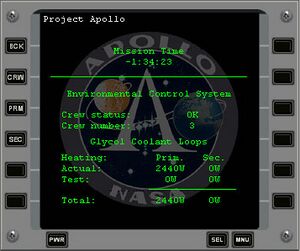ProjectApolloMFD: Difference between revisions
No edit summary |
No edit summary |
||
| Line 1: | Line 1: | ||
[[Image:ProjectApolloMFD.jpg|thumb|right|Screenshot of the ECS screen.]] | [[Image:ProjectApolloMFD.jpg|thumb|right|Screenshot of the ECS screen.]] | ||
ProjectApolloMFD provides users with important mission information which cannot otherwise be accessed from within the simulation. Mission time, guidance parameters, environmental variables, and a TLI program are included. To access ApolloGuidanceMFD, activate it from the Modules tab of Orbiter's launchpad. | The '''ProjectApolloMFD''' provides users with important mission information which cannot otherwise be accessed from within the simulation. Mission time, guidance parameters, environmental variables, and a TLI program are included. To access ApolloGuidanceMFD, activate it from the Modules tab of Orbiter's launchpad. | ||
Revision as of 19:19, 15 April 2007

The ProjectApolloMFD provides users with important mission information which cannot otherwise be accessed from within the simulation. Mission time, guidance parameters, environmental variables, and a TLI program are included. To access ApolloGuidanceMFD, activate it from the Modules tab of Orbiter's launchpad.
Mission Time
Current mission time is always displayed in the upper portion of the MFD.
All other information is available on the various sub-screens, which are selectable from the main screen.
This screen displays relevant flight information:
- Velocity (ft/s)
- Vertical Velocity (ft/s)
- Altitude (nm)
- Apoapsis Altitude (nm)
- Periapsis Altitude (nm)
To access, press GNC on the main menu.
Environmental Control System (ECS)
This sub-screen contains two parameters:
- Crew Status
- Glycol Cooling Loops
The crew status parameter displays the number and status of the crew. Although basic, the simulation does take into account such variables as temperature, CO2 levels, and cabin/suit pressurization. Exposing the crew to inhospitable conditions will affect their life functions, and result in an appropriate warning displayed in the Crew Status field. The number of crew members can be changed by pressing CRW and a number from 1 to 3.
The second parameter involves the glycol coolant loops. These provide vital cooling to certain spacecraft systems, as well as to the crew's suits. Using the PRIM and SEC buttons, one can input power output values from -3000W to 3000W for either or both loops. The simulation of these systems is accurate, and effects of various power outputs on spacecraft systems can be observed.
To access, press ECS on the main menu.
TLI Burn Program (TLI)
This feature utilizes the SIV-B IU to perform a Trans-Lunar Insertion burn.
To use:
- Calculate time to ejection and delta velocity as usual and as you do for the Simple AGC P15 program (see TLI Checklist).
- Select Project Apollo MFD.
- Press TLI on the main menu.
- Press V and enter calculated delta velocity in m/s.
- Press T and enter the time until burn commences (ex. 1200 for 1200s).
- Wait until time to ejection is exactly 1200s and press RUN, the status changes to WAITING. You can stop the burn by pressing STP.
- At 900s before time to ejection the burn data are passed to the IU. Status changes to RUNNING, you cannot stop the burn with the MFD. However, you can inhibit the TLI burn sequence by switching the XLUNAR INJECT switch to SAFE until 18s before SIV-B ignition, after that you can do this by using the S-II/S-IVB LV STAGE switch (permanent inhibit when used 12s after SIV-B ignition or later) as ususal. Now the time to burn is displayed counting down.
- At T-0:00 the IU performs the burn. Once it is complete, the status in the MFD changes to OFF, press BCK to disable the IU TLI burn program.
- If something goes wrong (if you try to do a TLI burn while sitting on the launch pad for instance) the status changes to ERROR, press STP and try again...